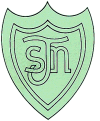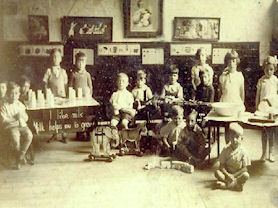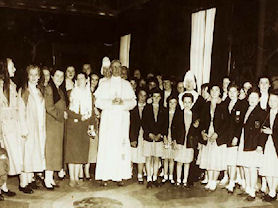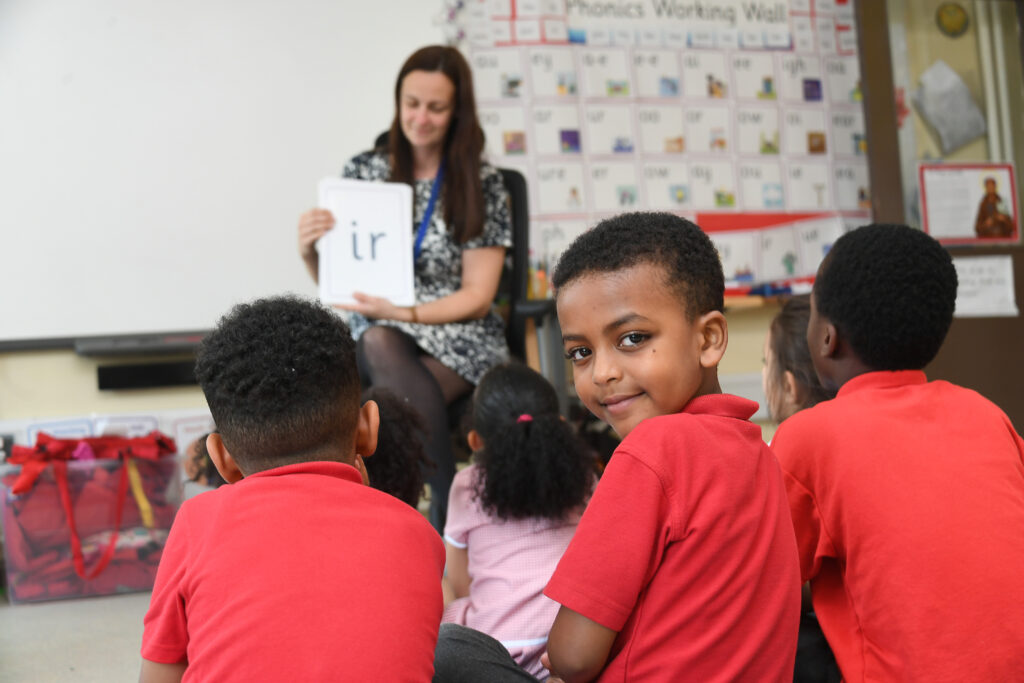History
Our school has a very interesting history. This is the story of St Joseph’s school from 1867 onwards:

For several years, before 1867, a Mrs Jane Wheatley had kept a school at her house. On Sundays, she would allow all the Catholic children to meet there after mass. Mr Smallwood, Miss Wheatley and Miss Smallwood taught them. Mr Joseph Rigby would later join them. At this time, the visiting priest would also tutor the pupils with catechism instruction. An average attendance would consist of about 35 pupils. This was the very beginning of St Joseph’s School.
In the 19th century, schools were not given any money from the Government – all building work and teachers’ wages had to be paid by the community or by sponsors.

It is clear that the need for a school within the area had been identified. On 2nd April 1865, door-to-door collections began to raise funds in order that one could be established. By 14th April 1867, some £115.7s.6p had been raised. On his arrival in the parish, Father Greaney was presented with this money, together with a plan for a school that would cost £200 to build. Further support from senior diocesan clergy ensured that a school would be built.
The school was built at the side of the church, with an entrance from Long Acre. The school opened on 7th July 1868 and consisted of two schoolrooms. Fifty pupils enrolled. The cost of the building, with accommodation for teachers, was £1,000.
Within a short time it was decided that the priest should in fact use the house that had been set-aside for the teachers, for security reasons. It has to be remembered that a number of anti-Catholic riots did occur in Birmingham around this time. St Chad’s did receive damage to windows in one such attack.
The Sisters of Charity of St Paul the Apostle founded and ran many Catholic schools in the Midlands. Their Mother House had been opened at Selly Park in 1864, and at the request of Bishop Ullathorne, the Sisters were asked to come to St Joseph’s. They lived in the Convent at 143 Nechells Park Road, from 13th July 1868 until it was closed on the 24th December 1953. The two sisters who were currently teaching at St Joseph’s continued to do so but now resided at St Chad’s Convent. The first Headmistress was Mother Regis and the Sisters would continue teaching in the School until 1966.
In 1870, the school was extended, as there were many more pupils. The classrooms were level with Long Acre and built on arches, which provided a covered playground for the pupils. The arches were eventually utilised and made into classrooms. The fees in 1874 were 1d – 4d (I/2p – 2p approx.) per week and over half the places were free.
In 1877, the school was divided into three separate departments – infants, girls and boys, each with its own Headteacher. The school’s needs continued to expand. By 1896, Father Chattaway commissioned a single storey building to be built at the Thimble Mill Lane entrance to the church. This was originally the boys’ school, and remained there until demolished in May 1998 for road widening. The number of pupils in the three schools was usually about 600.

Around 1920, Nechells was subject to slum clearance and people were moved away. The numbers of pupils dropped drastically. During the war years, pupils were evacuated out of the city. The depleted boys’ and girls’ schools were amalgamated and by 1950, there were only 111 pupils on roll. The boys’ school building was used as an annexe for the younger pupils.
The Second World War, 1939 – 1945
When war was declared, St Joseph’s parents had already been told of the Evacuation Plans for their children, a rehearsal for which was held on 28th August 1938. On 1st September, only 19 Infants arrived. The party set off to Hartshome village, near Burton-on-Trent, where they stayed with families.

Birmingham suffered many air raids. In August 1940, the raids were particularly heavy and attendance at school the next day was not always possible. On 26th August, bombs went off in the cemetery, but the school was not damaged.
The HM Inspectors visited the school in November 1941, January 1943 and April 1944. As one past pupil said of the time: “St Joseph’s School was always normal and stable, whatever turmoil was happening in the outside world”.
When school reopened in January 1944, attendance was much improved – 91 children were present out of 99 in the infants.
In November 1944, the children who had school lunches provided would go to Charles Arthur Street Canteen together with a teacher, as St Joseph’s did not have any facilities. Most of the other children lived close enough to go home for lunch.
Finally, peace came to Britain. On 8th and 9th May 1945, School was closed for VE Day Peace celebrations.

In 1953, St Joseph’s became an aided school. For many years, the buildings were in poor condition, but by 1961, there were nine classrooms. The infants and juniors were amalgamated into one school in 1963.
In 1968, under Bishop Emery’s direction, a new school was built in Rocky Lane. This was completed and the first pupils moved in on 27th April 1969. The blessing and formal opening of the school took place on 9th December 1970, in the presence of the Most Rev George Patrick Dwyer.
This modern, airy building, with lots of windows and space, was very different to the original building, which was demolished in the 1970s. The school was enlarged in 1992, when a library and more office space were created at the front of the school.
In 1998, St Joseph’s passed both the Catholic and the OFSTED inspections. The school has regularly been inspected, and has always passed even when the environment was very poor.
A past pupil says of St Joseph’s: “The single most enduring influence in my life: my school. We were poor, we were underprivileged, the school was ill-equipped, the classes were large but the teachers worked flat out to give us grounding for life. I developed a love of learning there. Above all, we were a Catholic school, with Catholic values”.
Taken from ‘Where Buildings Once Stood’ by kind permission of Mr Richard Scott.



